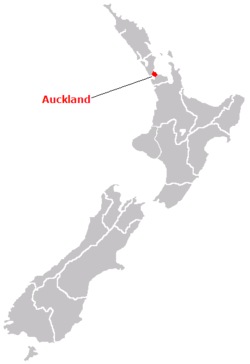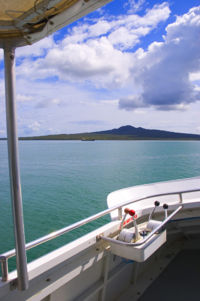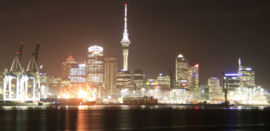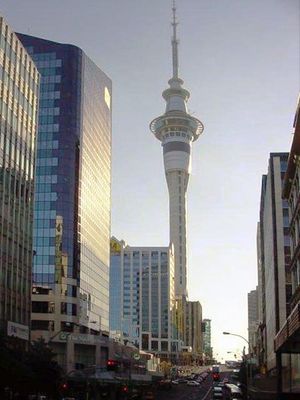Auckland
2007 Schools Wikipedia Selection. Related subjects: Geography of Oceania (Australasia)
| Auckland | |
| Population: | 1,241,6001 |
| Area: | 1,086 km² (419 sq mi) |
| Location: | |
| Mayor: | Multiple, including Dick Hubbard, Sir Barry Curtis, Bob Harvey, John Law, George Wood |
| Urban Area | |
|---|---|
| Extent: | North to Waiwera, northwest to Kumeu, east to Maraetai, south to Drury and Runciman; excludes Waitakere Ranges & Hauraki Gulf Islands |
| Territorial Authorities | |
| Names: | Auckland City North Shore City Urban parts of Waitakere City and Manukau City |
| Regional Council: | Auckland |
| 1 Statistics New Zealand estimated resident population, Auckland Urban Area, 30 June 2005. | |
The Auckland Metropolitan Area, or Greater Auckland, in the North Island of New Zealand, is the largest urban area in New Zealand. With over 1.2 million people it has over a quarter of the country's population, and demographics trends still cause it to grow faster than the rest of New Zealand.
It is a conurbation, made up of Auckland City (excluding the Hauraki Gulf islands), North Shore City, and the urban parts of Waitakere and Manukau cities, along with Papakura District and some nearby urban parts of Rodney and Franklin Districts. In Māori it bears the traditional name Tāmaki Makau Rau or the transcribed version of Auckland, Ākarana.
Auckland lies between the Hauraki Gulf of the Pacific Ocean to the east, the low Hunua Ranges to the south-east, the Manukau Harbour to the south-west, and the Waitakere Ranges and smaller ranges to the west and north-west. The central part of the urban area occupies a narrow isthmus between the Manukau Harbour on the Tasman Sea and the Waitemata Harbour on the Pacific Ocean. It is one of the few cities in the world to have harbours on two separate bodies of water.
History
Early Māori and European settlers
The isthmus was first settled around 1350 and was valued for its rich and fertile land. Many pa (fortified villages) were created, mainly on the volcanic peaks. Māori population is estimated to have peaked at 20,000 before the arrival of Europeans. This event - and the guns which they traded to local iwi - upset the local power balances. This resulted in extensive inter-tribal warfare, which together with some introduced plagues resulted in the area having relatively low numbers of Māori when European settlement in New Zealand started in earnest (there is however no indication that this was the result of a deliberate European policy).
Birth of the city
After the signing of the Treaty of Waitangi in February 1840 the new Governor of New Zealand, William Hobson chose the area as his new capital. However, even in 1840, Port Nicholson (later Wellington), was seen as a better choice for an administrative capital, due to its closeness to the South Island, which was being settled much faster.
Nonetheless, even after losing its status as capital in 1865, immigration to the new city stayed strong.
Growth up to today
Becoming a base against the Māori King Movement in the early 1860s, and continued road building towards the south into the Waikato, enabled Pākehā (White New Zealanders) influence to spread out from Auckland. It also grew fairly rapidly, from 1,500 in 1841 to 12,423 by 1864. The growth occurred similarly to other mercantile-dominated cities, mainly around the port, and with many of the problems of overcrowding and pollution common to it.
Trams and railway lines shaped Aucklands rapid extension in the early first half of the 20th century, but soon after, the dominance of the motor vehicle emerged, and has not abated since, with aterial roads and motorways becoming a defining (and geographically dividing) feature of the urban landscape. They also allowed further massive expansion, resulting in the growth of associated urbanities like North Shore (especially after the construction of the Auckland Harbour Bridge, and Manukau City in the south.
To this day, a large percentage of Auckland is still dominated by a very suburban style of building, giving the city a very low population density: although it has not much more than a seventh of the population of London, it sprawls over a considerably larger area - a fact that serves to make public transport by Auckland's rail and bus systems unpopular and uneconomic (car usage costs fall slightly with decreasing urban density, while public transport costs rise sharply, even if less capital-intensive types like bus services are used in the less dense zones).
Future growth
Aucklands problems with urban sprawl, due to rapid population growth and its automobile-centred transportation system, are now slowly being addressed in planning. As Auckland is set to grow to an estimated 2 million inhabitants by the year 2050, a Regional Growth Strategy was adopted, which sees limits on further subdivision and intensification of existing use as its main sustainability measures.
Geography and climate
Volcanoes
Auckland straddles the volcanoes of the Auckland Volcanic Field. The 50 volcanic vents in the field take the form of cones, lakes, lagoons, islands and depressions, and several have produced extensive lava flows. Most of the cones have been partly or completely quarried away. The volcanoes are all individually extinct, although the volcanic field itself is merely dormant.
The most recent and by far the largest volcano, Rangitoto Island, was formed within the last 1000 years, and its eruptions destroyed the Māori settlements on neighbouring Motutapu Island. Rangitoto's size, its symmetry, its position guarding the entrance to Waitemata Harbour and its visibility from many parts of the Auckland region make it Auckland's most iconic natural feature. It is eerily quiet as almost no birds and insects have settled on the island because of the rich acidic soil and type of flora that has adapted to grow out of the black broken rocky soil.
Hauraki Gulf islands
Several islands of the Hauraki Gulf are administered as part of Auckland City, though they are not officially part of the Auckland metropolitan area. Parts of Waiheke Island effectively function as Auckland suburbs, however, while various smaller islands near Auckland are mostly recreational open space or nature sanctuaries.
Isthmus and harbours
Auckland lies on and around an isthmus, less than 2 kilometres wide at its narrowest point, between Mangere Inlet and the Tamaki River. There are two harbours in the Auckland urban area surrounding this isthmus, Waitemata Harbour to the north, which opens east to the Hauraki Gulf, and Manukau Harbour to the south, which opens west to the Tasman Sea.
Bridges span parts of both these harbours, most notably the Auckland Harbour Bridge crossing the Waitemata Harbour west of the Auckland CBD. The upper reaches of the Manukau and Waitemata Harbours are spanned by Mangere Bridge and the Upper Harbour Bridge respectively. In earlier times, portage paths connected both sides of the sea at the narrowest sections of the isthmus.
Climate
Auckland has a warm-temperate climate, with warm, humid summers and mild, damp winters. January temperatures average 21-24 °C. February can be warmer than January, but temperatures rarely exceed 30 °C July maximum temperatures average 14-16 °C. High levels of rainfall occur almost year-round (an average of 1249 mm per year), especially in winter. Climatic conditions vary in different parts of the city owing to geography such as hills, land cover and distance from the sea. On 27 July 1939 Auckland received its only snow fall in recorded history. This is unlike some South Island cities like Christchurch, which regularly gets snow down to sea level.
The unusual early morning calm on the isthmus during settled weather, before the sea breeze rises, was described as early as 1853: "In all seasons, the beauty of the day is in the early morning. At that time, generally, a solemn stillness holds, and a perfect calm prevails..." Many Aucklanders use this time of day to walk and run in parks.
As car ownership rates are very high, and emissions controls relatively weak in New Zealand, Auckland suffers from an elevated level of air pollution. This can sometimes be visible as smog, especially on calm winter days. However, the maritime local climate ensures that most pollution is eventually dispersed, and thus the smog never reaches levels as seen, for example, in Los Angeles or Mexico City.
People
Cultures
Auckland serves as a home to many cultures. The majority of inhabitants claim European - predominantly British - descent, but substantial Māori, Pacific Islander and Asian communities exist as well. Auckland has the largest Polynesian population of any city in the world.
A large proportion of the population is also made up of people of Asian origin (mainly East Asian and South Asian). This is due to New Zealand's world-leading level of immigration, which flows primarily into Auckland. Ethnic groups from all corners of the world have a presence in Auckland, making it by far the country's most cosmopolitan city. It is estimated that over 14 people from other countries immigrate to Auckland every day. This strong focus on Auckland has led the immigration services to award extra points towards immigration visa requirements for people intending to move to other parts of New Zealand.
The 2001 New Zealand Census showed that:
- 66.9% of people in the Auckland Urban Area belong to European ethnic groups.
- 14.9% of people in the Auckland Urban Area belong to Pacific Island ethnic groups.
- 14.6% of people in the Auckland Urban Area belong to Asian ethnic groups.
- 11.5% of people in the Auckland Urban Area belong to the Māori ethnic group.
- 1.3% of people in the Auckland Urban Area belong to other ethnic groups.
(These percentages do not add up to 100%, as some people belong to more than one ethnic group).
Religion
Like the rest of the country, more than half of Aucklanders are nominally Christian, but fewer than 10% regularly attend church and almost 40% profess no religious affiliation (2001 census figures). The main denominations are Anglican, Presbyterian and Roman Catholic. Pentecostal and charismatic churches are the fastest growing. The charismatic and fundamentalist Destiny Church, headquartered in Auckland, has gained headlines because of its political activities. A higher percentage of Polynesian immigrants are regular churchgoers than other Aucklanders, although church attendance drops off in second- or third-generation Polynesian Aucklanders. Other immigrant cultures have added to the religious diversity of the city, adding faiths such as Buddhism, Hinduism, Islam and Sikhism to Auckland's religious landscape. There is also a small, long-established Jewish community. There is an even smaller Rationalist group.
Lifestyle
Positive aspects of Auckland life are its mild climate, plentiful employment and educational opportunities, as well as numerous leisure facilities. Meanwhile, traffic problems (compared to other New Zealand cities), the lack of good public transport, and increasing housing costs have been cited by many Aucklanders as among the strongest negative factors of living there , together with crime (which is still low for a city of its size ). Nonetheless, Auckland currently ranks 5th behind Zurich and Geneva in a survey of the quality of life of the world's top 55 cities . In 2006, Auckland also placed 23rd on the UBS list of the world's richest cities.
Leisure
Auckland is popularly known as the "City of Sails" because the harbour is often dotted with hundreds of yachts and has more per capita than any other city in the world. Viaduct Basin hosted two America's Cup challenges, and its cafes, restaurants, and clubs add to Auckland's vibrant nightlife.
High Street, Queen Street, Ponsonby Road, and Karangahape Road are also very popular with urban socialites. Newmarket and Parnell are upmarket shopping centres. Otara's and Avondale's famous fleamarkets and Victoria Park Market are a colourful alternative shopping experience. There are major shopping malls at Sylvia Park, Botany Town Centre, Albany, and St Lukes.
The Auckland Town Hall and Aotea Centre host conferences and cultural events such as theatre, kapa haka, and opera. Many national treasures are displayed at the Auckland Art Gallery, such as the work of Colin McCahon.
Other significant cultural artefacts reside at the Auckland War Memorial Museum, the National Maritime Museum, and the Museum of Transport and Technology (MOTAT). Exotic creatures can be observed at the Auckland Zoo and Kelly Tarlton's Underwater World. Movies and rock concerts (notably, the " Big Day Out") are also well patronised.
Parks & Nature
Auckland Domain is one of the largest parks of the city, situated close to the CBD and having a good view of the bay and of Rangitoto island. Smaller parks also close to Queen Street are Victoria Park, Myers Park and Albert Park.
Most of the remaining volcanic cones are surrounded by parks, with notable examples including Mount Eden, Mount Victoria and One Tree Hill (Maungakiekie). Western Springs has a large park bordering on the MOTAT and the Zoo. The Auckland Botanical Gardens are well to the south of the main city.
Ferries provide transport to Devonport, Waiheke Island and Rangitoto Island. The Waitakere Ranges Regional Park to the west of the Region offers beautiful and relatively unspoiled 'bush' territory.
Sport
Auckland has its fair share of rugby and cricket grounds, and venues for motorsports, tennis, badminton, swimming, soccer, rugby league, and many other sports.
- Eden Park is the city's primary stadium and a frequent home for All Blacks rugby and Black Caps cricket matches.
- Mt Smart Stadium is used mainly for rugby league and soccer matches, but also used for concerts.
- Western Springs Stadium is a natural amphitheatre used mainly for speedway races, rock and pop concerts.
Waitemata Harbour has popular beaches at Mission Bay, Devonport, Takapuna, Long Bay and Maraetai, and the west coast has popular surf spots such as Piha and Muriwai. Many Auckland beaches are patrolled by surf lifesaving clubs which are part of Surf Life Saving Northern Region.
Popular annual sporting events include:
- The 'Cross Harbour Swim' from Devonport to the Auckland CBD is a yearly summer event.
- The 'Round the Bays' fun-run, starting in the city and going 8.4 kilometres (5.2 miles) along the waterfront to the suburb of St Heliers. It attracts many tens of thousands of people and has been an annual March event since 1972.
- The Auckland Marathon (and half-marathon), an annual competition for thousands of enthusiasts, with the course going over the Harbour Bridge from North Shore and ending in the Auckland CBD (with a detour to Mission Bay for those doing the full distance).
Work
Every business day, many professional and other service workers commute from all points of the region to downtown Auckland, often enduring long commuting times, drawn by and making Auckland City one of the best-earning cities in New Zealand with a median personal income per year of NZ$ 22,300 (2001), behind only North Shore City (also part of the Greater Auckland area) and Wellington. While office workers still account for a heavy part of the CBD commutes, large office developments in other parts of the city, for example in Takapuna, North Shore City, are becoming more common.
Most major international corporations have an Auckland office, as the city is seen as the economic capital of the nation - although many firms increasingly run their New Zealand operations from Australia. The most expensive office space is around lower Queen Street and the Viaduct Basin. A large proportion of the technical and trades workforce is based in the industrial zones of South Auckland.
The largest commercial and industrial areas of Greater Auckland are in the southeast of Auckland (City) as well as in the western parts of Manukau City, mostly in the areas oriented towards the Manukau Harbour and the Tamaki River estuary.
Housing
Housing varies considerably between some suburbs having state owned housing in the lower income neighbourhoods, to palatial waterfront estates. The most common residence of Aucklanders is a bungalow on a " quarter acre" (1,000 m²), with the resulting large urban sprawl and reliance on motor vehicles. The regional council is trying to curb this trend, with housing density strategies such as more townhouses and apartments, and prohibiting subdivision of properties on the city fringes.
In some areas, the Victorian villas are being increasingly torn down to make way for large plaster mansions with tennis courts and swimming pools. The rampant demolition of the older properties is being combatted by the Auckland City Council passing laws that cover heritage suburbs or streets.
Transport
Dominance of vehicle transport
Auckland is highly dependent on private vehicles as the main form of transportation, to a level unusual for such a large city. This results in substantial traffic congestion during peak times, especially for New Zealand levels, though comparable to many other cities worldwide.
With public transport usage declining heavily during the second half of the 20th century, and increased spending on roading and motorways, New Zealand (and specifically Auckland) now has the second-highest vehicle ownership rate in the world, with around 578 vehicles per 1000 people. This focus has been partly due to the low population density of the Auckland region (again, similar to New Zealand in general terms), making public transport less cost-effective when compared to denser urban centres in other parts of the world. Auckland thus suffers from associated problems such as chronic traffic congestion on the main routes, and vehicle-induced air pollution. Recent studies show that New Zealanders take less than 2% of all journeys by bus and only 1% of journeys by rail.
Road network
The State Highway network connects the cities located in the Auckland urban area. The most frequently travelled being the Northern, Southern, Northwestern and Southwestern Motorways. The Western Ring Route is currently under construction. The Auckland Harbour Bridge is the main connection to North Shore City.
The main arterial roads within Greater Auckland are Great North Road and Great South Road, the main connections in those directions before the construction of the State Highway network.
Other modes of travel
Public transport use is still very light in terms of the modal share, and remains widely unpopular and expensive in spite of recent increases in ridership and funding.
- Auckland has two main railway trunk lines, serving the general western and southern directions from the Britomart Transport Centre in downtown Auckland.
- An integrated bus network has resulted in increased patronage and service, but service is still limited in comparison to other cities of the same size (and higher density). The services are mostly spoke-, as opposed to ring-routes, due to the location of Auckland within the narrow sections of the isthmus. Services rarely run late into the night.
- Auckland CBD is connected to various outlying coastal suburbs and North Shore City via ferries. The same ferry terminal also services outlying islands for commuters and tourists.
Auckland has various small regional airports as well as Auckland International Airport, the busiest of the country.
Attractions and landmarks
The following is a list of tourist attractions and landmarks in the Auckland Metropolitan Area:
- Auckland Domain - one of the largest parks of the city, situated close to the CBD and having a good view of the bay and of Rangitoto island.
- Auckland War Memorial Museum - a large multi-exhibition museum located in the Auckland Domain, also known for its impressive classicist style.
- Aotea Square, and Queen Street - the hub of downtown Auckland, often the site of crafts markets, rallies or arts festivals.
- Botany Town Centre, Howick - a complete shopping complex, one of the largest in Auckland includes a cinema, bowling alley, food court and many shops to visit.
- Britomart Transport Centre - the downtown train and bus centre housed in a historical building.
- Eden Park - the city's primary stadium and a frequent home for All Blacks rugby and Black Caps cricket matches.
- Harbour Bridge - connecting Auckland and the North Shore is an iconic symbol of Auckland.
- Karangahape Road - known as K' Road, a street in upper central Auckland, famous for its bars, clubs and smaller shops.
- Kelly Tarlton's Underwater World - a well-known Auckland aquarium in the eastern Mission Bay suburb, built in a set of former sewage storage tanks, and showing fish like Sharks.
- MOTAT - Aucklands Museum for Transport and Technology, with its main site at Western Springs.
- Mount Eden - a volcanic cone with a grassy crater, it offers a nice view of Auckland and the surrounding area, being the highest point in Auckland and a famous tourist destination.
- Mt Smart Stadium - a stadium used mainly for rugby league and soccer matches. Also used for concerts.
- Mount Victoria, although slightly out-of-the-way for the casual tourist, offers a spectacular view of the city. A brisk walk from the Devonport Ferry terminal, the cone is steeped in history as is the nearby North Head.
- One Tree Hill (Maungakiekie) - a volcanic cone which dominates the skyline in the southern, inner suburbs. It no longer has a tree on the summit, instead being crowned by an obelisk.
- Ponsonby Road - a road (and suburb) west of central Auckland known for arts, cafes and culture.
- Rangitoto Island - guards the entrance to Waitemata Harbour, and forms a prominent feature on the eastern horizon.
- Sky Tower - the tallest free-standing structure in the Southern Hemisphere, stands 328 m tall.
- Sylvia Park - a shopping complex in Mount Wellington opened in June 2006. Once completed it will become one of the largest malls in the southern hemisphere. It contains the largest Warehouse store in New Zealand.
- Viaduct Basin - a marina in downtown Auckland, venue for the America's Cup regatta 2000 and 2003. It is now a thriving commercial centre and has many new upscale residential buildings.
- Western Springs Stadium - a natural amphitheatre used mainly for speedway races, rock and pop concerts.









